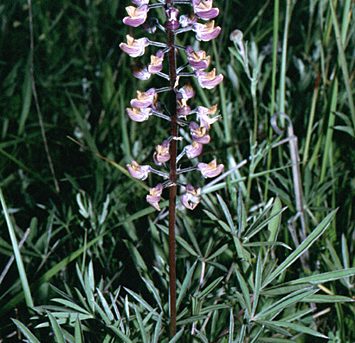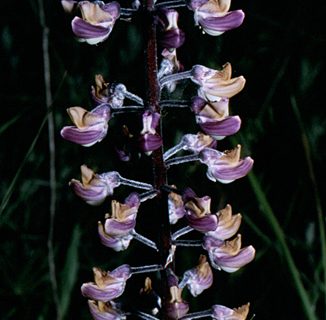Kincaid’s lupine
Lupinus sulphureus Douglas ex Hook. ssp. kincaidii (C.P. Sm.) L.Ll. Phillips (Kincaid’s lupine)
by Charlene Simpson
Family:
Fabaceae (pea family)
Synonymy:
- Lupinus leucopsis J. Agardh var. hendersonianus C.P. Sm.
- Lupinus oreganus A. Heller var. kincaidii C.P. Sm.
- Lupinus sulphureus Douglas ex Hook. var. kincaidii (C.P. Sm.) C.L. Hitchc.
Status (ORNHIC, 2007):
- Federal Endangered Species Act – Threatened
- Oregon Department of Agriculture – Threatened
- Oregon Natural Heritage Information Center – List 1 (Threatened or Endangered Throughout Range)

Description:
Perennial with numerous mostly unbranched stems, 16-32 inches tall. Basal leaves usually present and persistent until after flowering. Lowermost petioles 3-5 times as long as the blades; upper stem leaves with petioles sometimes shorter than the blades. Leaflets 6-11. Flowers numerous, but uncrowded on 4 to 7 inch raceme in a more or less whorled pattern. Corollas violet purple or paler. Banner shorter than the wings, not much reflexed. Keel sharply bent upward. Calyx swollen, but not spurred (Gilkey and Dennis, 2001; Hitchcock, et. al., 1961).
Identification tips:

With its low growing habit and unbranched inflorescence, Kincaid’s lupine is distinguished from other perennial lupines occurring in the same range. Its lack of a spur sets it apart from spurred lupine (Lupinus arbustus). Hybrids between Lupinus arbustus and Lupinus sulphureus ssp. kincaidii occur which show characters of both parents.
Phenology:
Flowers April through June.
Distribution:
Lewis County, Washington and Willamette Valley, Oregon, from Washington County to Lane County, with a few additional populations in Douglas County (Wilson et al., 2003).
Habitat:

Lupinus sulphureus ssp. kincaidii is found in native upland prairies with well-drained soils and no prolonged standing water, as well as in open oak woodlands. Natural habitat is now largely degraded and fragmented by conversion to agricultural use in the 150 years following Euro-American settlement. Kincaid’s lupine persists today in privately owned prairie remnants, in agency protected reserves and along roadsides. Less than 1 percent of native Willamette Valley prairie remains intact compared with 200 years ago (Wilson et. al., 2003).
Ecology:
The early seral prairie habitat occupied by Lupinus sulphureus ssp. kincaidii was historically maintained by periodic disturbance. Before Euro-American settlement the Willamette Valley was subject to seasonal burning by the Native American tribes of the area (Meacham, 1990). Burning maintained the open prairie by controlling invasive trees and other woody species.

Kincaid’s lupine is the primary larval host plant of the Fender’s blue butterfly (Plebejus icarioides fenderi), although its caterpillars also have been observed on sickle-keeled lupine (Lupinus albicaulis) and spurred lupine (Lupinus arbustus). Adult butterflies lay their eggs on the lupine host plants during May and June (Schultz et al., 2003). Newly hatched caterpillars feed and develop on the host plant until they transform into adult butterflies the following spring. The butterfly’s larvae overwinter at the base of the plant (USFWS, 1998).
Fender’s blue butterfly was thought to be extinct in Oregon. It had not been seen for 50 years until rediscovered in 1989 by OSU lepidopterist Paul Hammond (Wilson, et. al., 1997). In January 2000 the butterfly was listed as endangered by the Federal Endangered Species Act; in the same action, Kincaid’s lupine was listed as threatened (Federal Register, 2000).
Political Action:
In 2003 five Eugene-based conservation groups successfully sued the U.S. Fish and Wildlife Service to formally designate critical habitat for three species (Kincaid’s lupine, Fender’s blue butterfly, and Willamette daisy) found in isolated pockets of the Willamette Valley. The Native Plant Society of Oregon was one of the plaintiffs who argued that the Fish and Wildlife Service was moving too slowly to designate critical habitat as required by law. U.S. Fish and Wildlife defended the delay due in part to their efforts to draft a comprehensive recovery plan for prairie species (Maben, 2003).
In 2005 the agency was faulted by judges for failing to conduct reviews to determine if species listed under the Endangered Species Act deserve a greater or lesser level of protection, no change, or removal from the list. Kincaid’s lupine and Fender’s blue butterfly were among five Pacific Northwest species that had not been reviewed as required by law (Bolt, 2005).
Conservation concerns:
1. Habitat loss from agriculture and urban development poses the greatest threat to Kincaid’s lupine and the Fender’s blue butterfly (Wilson, et. al., 1997).
2. The open prairie habitat required by the species is threatened by woody plant succession (Wilson et. al., 2003).
3. Aggressive exotic species, such as Scot’s broom (Cytisus scoparius) and Himalyan blackberry (Rubus armeniacus), threaten habitat quality (Wilson, et. al., 1997).
4. Non-native grasses such as oatgrass (Arrhenatherum elatius) compete for water in low-rainfall years (Wilson and Clark, 2001).
5. The increasing isolation and fragmentation of the remaining sites limits opportunities for adult pollinator movement between populations. Lost pollinator connectivity reduces fruit production (Wilson et. al., 2003).
6. Lost opportunity for pollination from outside populations results in inbreeding which depresses survival because of reduced gene exchange and loss of genetic diversity. (Liston, et. al., 1995).
7. Roadside maintenance involving herbicide application or mowing reduces or even eliminates populations (USFWS, 2006).
References:
- Bolt. G. 2006. Zooming in on species protection. In The Eugene Register Guard. July 13.
- Federal Register. 2000. Federal Endangered Species: Rules and Regulations. Vol. 65. No. 16. January 25.
- Gilkey, H.M. and L.J. Dennis. 2001. Handbook of Northwestern Plants. Revised edition. Oregon State University Press. Corvallis, Oregon.
- Liston, A., K. St. Hilaire, and M.V. Wilson. 1995. Genetic diversity in populations of Kincaid’s lupine, host plant of Fender’s blue butterfly. Madrono 42(3): 309-322.
- Maben, S. 2003. Groups settle lawsuit over butterfly. In The Eugene-Register Guard. Eugene, Oregon. November 22.
- Meacham, J.E. 1990. Atlas of Lane County Oregon. QSL Printing Co., Eugene, Oregon.
- Oregon Natural Heritage Information Center. 2007. Rare, threatened and endangered species of Oregon. Oregon Natural Heritage Information Center, Oregon State University. Portland, Oregon.
- Robertson, L. 2000. Species listed as protected. In The Eugene-Register Guard. January 26.
- Schultz, C.B., P.C. Hammond, and M.V. Wilson. 2003. Biology of the Fender’s blue butterfly (Icaricia icariodes fenderi Macy), an endangered species of western Oregon native prairies. Natural Areas Journal 23:61-71.
- Severns, P.M. 2003. Propagation of a long-lived and threatened prairie plant, Lupinus sulphureus ssp. kincaidii. Restoration Ecology 11 (3), 334 342.
- U.S. Fish and Wildlife Service. 1998. Federal protection proposed for butterfly and two plants from remnant native prairie of Oregon’s Willamette Valley. U.S. Fish and Wildlife Service Regional News Release. January 27.
- U.S. Fish and Wildlife Service. 2006. Recovery Outline for Lupinus sulphureus ssp. kincaidii (Kincaid’s Lupine). Portland, Oregon. 23 pp.
- Wilson, M.V., P.C. Hammond and C.B. Schultz. 1997. The interdependence of native plants and Fender’s blue butterfly. Pages 83-87 in Conservation and Management of Native Plants and Fungi, T.N. Kaye, A. Liston, R.M. Love, D.L. Luoma, R.J. Meinke, and M.V. Wilson (eds). Native Plant Society of Oregon, Corvallis.
- Wilson, M.V., and D.L. Clark. 2001. Controlling invasive Arrhenatherum elatius and promoting native prairie grasses through mowing. Applied Vegetation Science 4:129-138.
- Wilson, M.V., T. Erhart, P.C. Hammond, T.N. Kaye, K. Kuykendall, A. Liston, A.F. Robinson Jr., C.B. Shultz, P.M. Severn. 2003. Biology of Kincaid’s lupine, Lupinus sulphureus ssp. kincaidii (Smith) Phillips, a threatened species of western Oregon native prairies. Natural Areas Journal 23:72-83.
